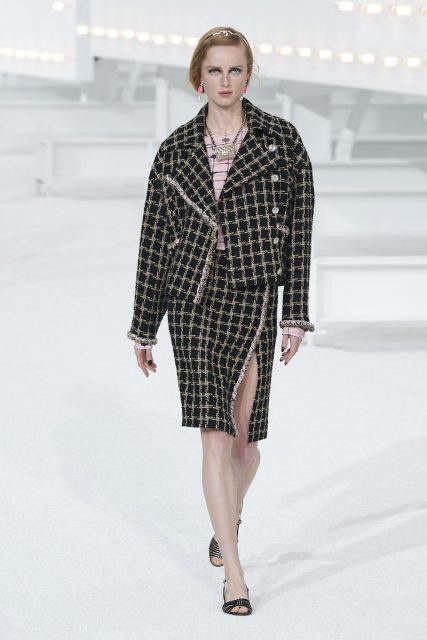For her graphic Chanel cruise collection Virginie Viard sought inspiration in Provence, that beautiful region in the south of France lapped by the marshy Camargue and crowned by the hills of Les Baux-de-Provence, considered one of the area’s loveliest villages. Specifically, she set the collection in the Carrières de Lumières (Quarries of Light) in Les Baux, a series of chalky, cave-like rooms—the spaces left behind after centuries of excavations.
These vast chambers have recently been used to present resonant sound and light shows evoking the world of various artists including Vincent van Gogh, who found inspiration in the local landscape. (Charlotte Casiraghi, hosting a literary salon during the presentation, has spent much of her life in nearby Saint Remy).
In 1960, however, Jean Cocteau—the sui generis artist, poet, and filmmaker who cast a long shadow across the worlds of culture and style in 20th century France—used these quarries as a setting for his hauntingly beautiful movie The Testament of Orpheus. It’s “so modern, so fresh, and so strong,” says Viard, who watched the movie, which features Cocteau himself, with cameos from his lover Jean Marais, Pablo Picasso, and Yul Brynner, among others, as she began working on the season. “The movie really inspired the collection,” Viard added. “When I came to see the quarry again—I’d been years ago, before it was used for the son et lumiere—I saw that the clothes had to be strong, and black and white. Otherwise we could be in Petra or Egypt. I love ruffles for the couture,” she continued, “but I thought it would not look modern here.”
Gabrielle “Coco” Chanel counted Jean Cocteau amongst her intimates; he produced some evocative portraits of her and illustrations of her clothes, and in turn she costumed productions of his plays Antigone, Orpheus, and Oedipus Rex. The friends would often hang out in Chanel’s daytime apartment on the Rue Cambon, and Viard was excited to read the letters that Cocteau sent to Chanel. The apartment has recently emerged from an extensive restoration, and Viard sought inspiration in the very personal bestiary that Chanel assembled there: The lions for that famous Leo, camels, doves of peace, fauns, and the female sphinxes that all appear in objects and sculptures in the apartment have been reimagined as graphic prints on denim with a hand-painted look, and as lucky charms used as embroidery in the new collection.
Viard worked with both Mod and Punk references: Striking black and white miniskirts, suits and coat dresses trellised with window pane blocks of small concrete beads (surplus stock from Montex’s embroidery for a Karl Lagerfeld Chanel couture show), and styling flourishes like fishnet stockings had a Mod sensibility. Accessories including zippered leather holster belts worn at the waist or thigh, handbag chain suspenders, and dog collars read as Punk, as did details like the rock and roll leather fringing on a shimmy dress, and the raw finishing used to hem the skirts and cuffs of caviar tweed suits and crochet minidresses (a Jean Cocteau sketch of a 1920s fringed Chanel dress was the starting point for these designs). The late Stella Tennant’s patrician Punk attitude inspired the lip piercing jewelry, as did Ines and Vinoodh’s photographs of the model Lola in Chanel’s apartment; Viard was thinking of a memorable Mario Testino image of Tennant dressed as a punk with her ball-gowned grandmother, the Duchess of Devonshire, at Chatsworth, her family’s storied stately home.
View this post on Instagram
Meanwhile the graphic suits—with a new jacket silhouette featuring a bloused body and fitted peplum—were drawn with the definite lines of Cocteau’s ink brush and pen drawings. (The famous star with which Cocteau signed his drawings was projected over the walls of the quarry during the show, and abstracted into prints for the collection). Chanel’s daring 1930s costume for a young Jean Marais in Oedipus Rex resembled bandages, and that idea of wrapping the body was echoed in the draped panels of a bodycon top that Viard paired with sarouel pants, and in the swathed skirts worn under long-bodied jackets.
There was more softness in the collection in ivory lace dresses scattered with embroidered good luck charms, and wide-legged, high-waisted white linen pants and cotton sweatshirting dresses embroidered with the wild flowers of Provence—lavender, thyme, Cosmos daisies, ranunculus, blue felicia, and scabious, among others. (Ines and Vinoodh photographed still lives of this beautiful flora for the accompanying catalogue of inspirations). Viard playfully suggested that the exotic silk hibiscus bloom (carried by the girls in the show) is this season’s camellia.
The only colors in the collection appear in 100% sustainable tweeds created by the embroiderer Lesage in what Viard described as a “Cézanne” palette, and used for skimpy, rough-fringed minisuits. For the finale, the short black velvet dresses, each worn with crochet and macramé capes, provided a theatrical flourish of which Cocteau would surely approve. And there’s a pragmatic reason for all those white ankle boots: “It’s better not to have a long black dress or black shoes if you are walking in a quarry all day!” confided Viard with a laugh.
Read Next
Editor
Hamish BowlesCredit
Photo Courtesy of Gorunway



